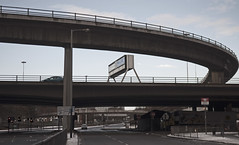With our street designers discovering some new technical terms and with budgets to commit before the end of the financial year, spring 2015 is shaping up to be a period we’ll look back on as one of the great waves of Crap Facilities.
Bus stop bypasses seem to be a big favourite of the bollocks cargo-cult imitations of infrastructure right now, from the weirdly, needlessly difficult:
Through the plain bizarre:
To the just bafflingly, utterly unusable wastes of money:
And from a quick scroll through @AlternativeDfT‘s timeline, I see junction designs that coroners have judged to be deadly — and which we know from extensive experience render the infrastructure simply unusable — are still the in thing:
https://twitter.com/RoastHse/status/600557556789026816Obviously robust and relevant design guidance and standards would help avoid this rubbish. And obviously short-term and unstable funding regimes with inadequate oversight have contributed to the madness. And obviously political pressure can sometimes stand in the way. But those alone can’t excuse professionals from squandering their budgets on quite obviously unusable, and quite plainly unused, bollocks.
I used to think it was sloppiness. That underpaid, underresourced and underappreciated council officers had understandably given up caring that their work is a waste of time where the product will be so shit nobody will use it.
But then you find them defending the rubbish…
…even trying to argue that the users are wrong…
And you realise these street designers don’t know the process of design.
The examples above, and the designers’ responses even more so, indicate that our streets are being designed with barely any understanding of people or how people use streets. No attempt has been made to understand what users need, or the experience of using the infrastructure they’ve designed.
This field has a problem with its attitude to users. From an understandable exasperation with users’ green ink suggestions, and mixed experiences with the statutory consultation process, officers can develop a general disdain for the user. Proper designers, though, are fine with the fact that users don’t always come up with sensible solutions. But proper designers know that what matters is users know what the problem is. And the users know what the experience of using the product is. And proper designers try to understand the problem, and proper designers try to check what the experience of using their design will be.
Proper designers don’t blame the user when their products turn out to be unusable.
I don’t blame the individuals who are given no time, training or support to do a proper design job. This is just another failure of the system.
We need the right design guidance, and we need the right funding framework, and we need the right political will. But we also need a proper user-centric design and consultation process. Safety audits? How about usability audits?














